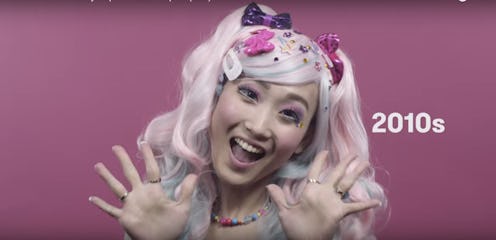
Over the past several months, videos showcasing 100 years of style and beauty have taken over the viral scene. Whether it's 100 Years of Workout Style or 100 Years of Beauty, seeing evolving perceptions of fashion and beauty is fascinating. Now, 100 Years of Japanese Beauty by Cut has arrived to showcase how their culture sees and expresses beauty. Meticulously researched by mother and daughter team Junko and Marina Taylor, the video takes a look at the nuances in modern Japanese beauty and the way Western fashions influenced the culture's style.
This isn't the first time that that Cut has created a 100 Year of Beauty video of a non-Western culture. They've created videos about Indian, Filipino, Iranian, and Chinese beauty just to name a few. What's particularly interesting about the videos is that it — as well as the others — is meticulously researched and often times by men or women native to the culture. Cut Video does an excellent job of representing cultural beauty in authentic ways unique to their production. I'd like to think that's what makes the videos such viral standouts.
In the Research Behind the Looks video, Junko and Marina Taylor explain decade by decade the styles featured in the short film. While the 100 Years of Japanese Beauty Video is fascinating, the video regarding the incredible amount of research is equally as fascinating.
So what decades did the Taylors showcase?
1920s: Urban Inspiration
According to the Taylors, Japan was urbanizing during this decade and received its first magazine directed toward women. The magazine featured a permed hairstyle that took root in Japanese beauty and resulted in the "hidden ear" hairstyle seen above.
1940s: WWII Influence
World War II strongly influenced Japanese style with many arguing against the ultra-modern, coifed look of the perm. Instead, according to Junko and Marina, self-restraint became an important part of Japanese style.
1970s: Model Inspiration
During the 70s, Japan was still in the middle of a post-war economic boom, and a fashion magazine took root in the culture. Sayoko Yamaguchi was Japan's first international supermodel, and her style provided gobs of inspiration to Japanese women.
1990: Culture & Subculture
The first look of the '90s is a one length, simple hairstyle, but according to the Taylors is representative of women who would have been more city and club savvy.
However, also in the late '90s, Tokyo street fashion truly emerged. The look came about as a subculture to counter beauty norms. Personally, I'm a sucker for the second look. I love when women push the boundaries.
2010s: Homogeneity Meets Uniqueness
The look for the 2010s is quite modern in my opinion and as weird as it sounds, pretty Zooey Deschanel-esque. The researchers explain that the look is based on the idea of a prettiness and sweetness in women, which may be where my Zooey comparison comes from.
In contrast, the Taylors explain the decora style of beauty. According to the pair, the look comes out of the well-known Harajuku style and features cheap, quirky accessories that allow a woman to stand out.
It's not doubt that each look was meticulously researched and executed, and it gives a unique glimpse into another culture's beauty.
While I reviewed some of the looks here, check out CutVideo's full video and the research video above for more details on each of the looks.
Want more beauty tips? Check out the video below, and be sure to subscribe to Bustle’s YouTube page for more hacks and tricks!
Images: TheCut/YouTube